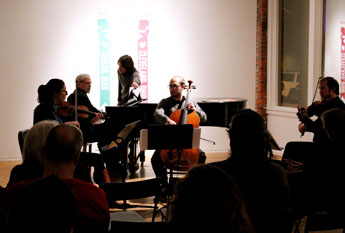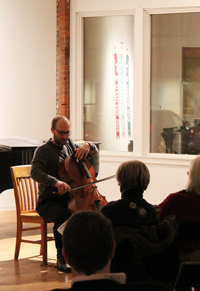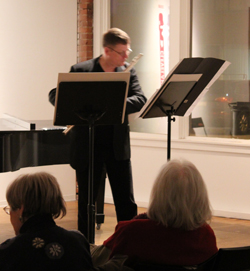by Jarrett Hoffman

SPACES provided a small, intimate setting, with three rows of chairs for the audience located only feet from the performers in the first room of the gallery. This, along with the art visible in the next room such as the “Twinkling Tricycle”— an antique tricycle wrapped in an absurd length of lights — lent a casual atmosphere to the concert.
The first piece, however, was anything but casual. Guest artist and virtuoso flutist Carlton Vickers performed Brian Ferneyhough’s first essay for solo flute, Cassandra’s Dream Song. Ferneyhough is known for his stunningly deliberate, complex pieces, and this one was no different. Rich with extended techniques, challenging runs, and strikingly dramatic silences, all pulled off expertly by Vickers, the piece also contained interesting aleatoricism: there were two stands in front of Vickers, and he switched between them repeatedly, choosing which section to play next. This only added to an edge-of-your-seat performance.

The piece itself followed the Ferneyhough well, employing its own extended techniques while shifting toward the mysterious world of Incan South America, with guitar-like strumming, drumming on the strings, and sounds reminiscent of bird cries (though in a more natural way than in Oliver Messiaen’s bird-inspired music). If the performer thought it was difficult, it didn’t show in a thoroughly engrossing performance.

The ensemble pieces on the program didn’t quite hold to the same extraordinary standard as the solo works. Violinist Cara Tweed, violist Tom Bowling and pianist Nicholas Underhill joined Diadore for Matthew Ivic’s Piano Quartet No. 2. The piece, receiving its world-premiere, was an interesting change of pace for its minimalism, but some of its sections felt imposed on the piece, perhaps because, as the composer emphasized before the performance, some of the material was left over from his Quartet No. 1. The very ending especially stuck out, an indulgently long, dissonant piano chord. And while intonation was great at the start — a challenging feat given the frequent minimalist unisons — it became an issue as the piece went on, as did rhythmic togetherness.
Ensemble problems also popped up in Andrew Rindfleisch’s Trio for Piano, Violin and Violoncello, with the composer conducting. At one point he had to stop the trio and have them restart. Though also a bit long-winded, the piece had some great moments, especially the slow section which showcased Diodore’s and Tweed’s beautiful, lyrical playing.
Throughout the concert, outside spontaneity intruded on the music: the floor creaked, the door to the building (one room over) opened and closed loudly, and voices could be heard as people entered. Interestingly, the level of distraction provided by these sounds varied by the piece. While the sounds clashed with the austere Ferneyhough pieces (even drawing glares from Vickers), a creak of the floor every now and then during the wild, fun Ginastera seemed to fit right in, as if — or perhaps simply as — music itself.
Photos by James Praznik.
Published on ClevelandClassical.com March 26, 2013
Click here for a printable version of this article.



